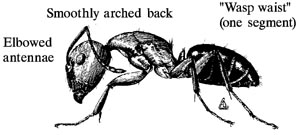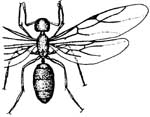by F.B. Peairs * (8/10)
Quick Facts…
- Large black or brown carpenter ants, winged or wingless, can cause serious damage if permitted to remain in the structural wood of a building.
- Winged carpenter ants often are mistaken for termites, a more serious problem.
- Winged ants inside or outside a home year-round indicate an infestation; seasonal presence is not as serious.
- Locating all nests is the most important and difficult step in controlling carpenter ants.
- Preventive measures will guard against carpenter ant infestations.
Carpenter ants prefer to nest in decayed, often water-damaged wood. Occasionally, they move into the sound structural wood of a building. If they are permitted to remain there, serious damage can result. Although carpenter ants can cause significant damage, problems develop slowly and there is plenty of time to plan safe and effective ways to control the infestation.
Carpenter ants are large black or brown insects in wingless and winged forms (Figures 1 and 2). Winged carpenter ants often are mistaken for termites (Figure 3), a more serious problem.
 |
|
| Figure 1: Carpenter ant worker. | |
 |
 |
| Figure 2: Carpenter ant, winged form. | Figure 3: Termite, winged form. |
Termites are easily distinguished from ants by straight rather than elbowed antennae, by forewings and hindwings of equal size, and, most notably, by the lack of the “wasp waist” just behind the legs that all ants have. Wingless carpenter ants are large, usually black, ants. They also are distinguished from other ants by a single segment forming the wasp waist at the front of the abdomen and by the smooth, arched profile of the back above the legs.
Large numbers of winged forms carpenter ants usually emerge from a nest during spring or early summer. They accumulate at windows and doors trying to find new nesting sites. Winged forms inside a home indicate a three- to four-year-old infestation that has considerable damage potential.
Another sign of infestation is the year-round presence of wingless forms searching for food. They are attracted to all sorts of animal and vegetable matter.
If their presence is seasonal, the nest is outdoors, and they have entered the house in search of food. In such cases, there will be an obvious path which can be followed back to the nest. Treat the path and nest as indicated below. Remove the infested wood and replace it if necessary.
Additional warning signs of carpenter ant activity are small piles of sawdust in isolated areas, such as crawl spaces or dark closets, and faint rustling noises in walls. Other insects and animals, however, also can make such noises.
Control of Infestations
The most important and difficult step in controlling carpenter ants is locating all of the nests. Check areas of the home that have had excess moisture problems, because carpenter ants frequently get their start in moist, decayed wood. Closely examine wood in contact with soil. Check house areas with a history of ant activity. Tap suspect wood and listen for rustling noises or movement.
Hollow-sounding wood also may indicate a problem. A sharp knife will easily penetrate the surface of infested wood. Once located, carpenter ant nests are distinguished from other insect damage by the presence of wide, irregular galleries that are smooth-surfaced and free of debris. Do not end the search with the discovery of a single nest — check all potentially affected areas. Nests in houses may be satellites of larger outdoor nests that also need to be destroyed to avoid reinfestation.
Extensively damaged wood may have to be replaced. If not, the nest and ant trails can be treated with an insecticide. Dust formulations are the most effective for carpenter ant control, as foraging workers become covered with the dust and carry it into the nest. Sprayable formulations are effective under some conditions. Several active ingredients are available. Nontoxic dusts that kill insects by causing them to dry out also can be effective in certain situations. Boric acid powder (Borid, Enuf, Roach Prufe, Roach Ridd, Roach Kil, etc.) is another low toxicity product that can be used in areas inaccessible to children and pets. Poison ant baits have worked well for carpenter ants under some conditions. As with any insecticide, read and follow all label instructions.
Preventing Infestations
Several steps can prevent the occurrence or recurrence of carpenter ant infestations:
- Correct any moisture problems that exist around the home, particularly in areas that have drainage or aeration problems, such as leaking roofs, gaps in siding, clogged gutters or faulty plumbing.
- Trim shrubbery and trees away from the house.
- Replace water-damaged or decayed wood. Wood should not be in contact with soil. This also is important in preventing termite damage.
- Remove stumps and dead trees. A 50-foot cleared perimeter around the house is recommended.
- It is not necessary to remove healthy trees, but remove or repair broken branches and any other damage or holes.
- Store firewood away from the house, preferably off the ground. This minimizes other insect problems associated with firewood. Bring inside only firewood that is about to be burned. Examine and discard heavily infested pieces.
*Colorado State University Extension entomologist and professor, bioagricultural sciences and pest management. 7/95. Revised 8/10.
Go to top of this page.





